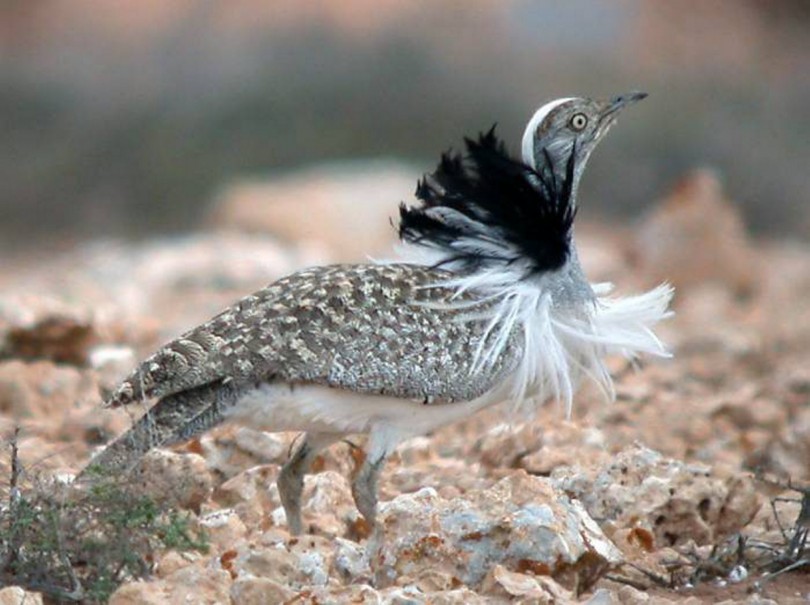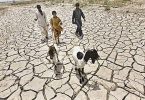“Game of the Rich”: The Dwindling Houbara Bustard Resources of Pakistan
Asian houbara bustard (Chlamydotis macqueenii ) is a member of the avian family Otididae commonly known as bustards.
Distribution
The Asian houbara bustard extends from Egypt east of the Nile to Mongolia and China (1,2) inhabiting Afghanistan, Bahrain, China, Egypt, India, Iran, Iraq, Jordan, Kazakhstan, Kuwait, Kyrgyzstan, Mongolia, Oman, Pakistan, Palestine, Qatar, Saudi Arabia, Syria, Tajikistan, Turkmenistan, UAE, Uzbekistan and Yemen, in addition to vagrant occurrences in Nepal and some parts of Europe. The species is regionally extinct in Turkey (3).
Biology and Ecology
All across its range, houbara bustard prefers open and arid to semi-arid areas generally with sparse shrubby vegetation. This ground-dwelling bird avoids woody habitats, areas near human settlements and those with extensive vegetation cover (2, 4).
Houbara bustard is an opportunistic omnivore with food ranging from small seedlings, leaves and insects to small snakes, rodents or even small birds. These desert-adapted bustards do not drink water directly rather intake it through food such as succulent shoots and young seedlings (2, 5).
Female lays 3-4 eggs by digging a shallow scrape in the ground (1, 3). These nests are vulnerable to predator attack for example by fox in the Nag Valley, Baluchistan (6). Parental care is exclusively provided by females; incubation lasts for 24 days and fledging for up to 35 days (1, 3).
Migration Patterns
Northern populations are migratory and winter in southern areas. Those from West-Kazakhstan mainly winter around Iraq-Iran border, while those from Central- and East-Kazakhstan winter in Afghanistan, Baluchistan, and a few reaching Thar Desert and South-Iran as well. Wintering grounds for Chinese houbara bustard populations are on the eastern edge of Karakum Desert in Turkmenistan and in Cholistan. Southern populations are largely sedentary and do not migrate up to long distances (7).
Houbara Bustard Population of Pakistan
The houbara bustard population of Pakistan comprises of two groups: breeding and wintering. Breeding populations are found in the remote areas of Baluchistan province including Nag Valley, Chagai, Panjgan and Kharan (6). These birds migrate to Sindh and Punjab to spend their winter. Arid and semi-arid areas of Baluchistan, Sindh and Punjab offer wintering grounds for immigrants from China, East- and Central-Kazakhstan, thus constituting the wintering houbara bustard population of Pakistan (6, 7).
Status
The Asian houbara bustard is classified as “vulnerable” on the IUCN (International Union for the Conservation of Nature and Natural Resources) red list; listed in the Appendix-I of CITES (Convention on International Trade in Endangered Species of Wild Fauna and Flora) and Appendix-II of CMS (Convention on the Conservation of Migratory Species of Wild Animals, also known as Bonn Convention). As per the Third Schedule of Baluchistan Wildlife Act (1974), “All Bustards” are listed as “Protected Animals”, i.e., animals which shall not be hunted, killed or captured.
Threats
Global population of Asian houbara bustard is estimated to lie between 78,960 and 97,000 individuals (8). The population is on decline throughout most of its range. Kazakhstan, the largest stronghold of this species (inhabited by almost half of total global population) experienced a decline by 26%-36% between 2000 and 2009 (9), mainly owing to over-exploitation in the wintering grounds of the species (3). Principal threats include illegal trade and over-hunting by falconers.
Illegal trade: Every year thousands of birds are captured in Pakistan and Iran for export to Arab states to be used in falcon training for sport. Most of the trade attempts are intercepted at the ports of entry or exit of these states and caught birds are released into the wild.
Falconry
Falconry refers to hunting of wild animals by using a trained bird-of-prey such as falcon, eagle or hawk. Houbara bustards are targeted at two steps in this sport: first in the training of flacons and then being hunted down by these trained raptors. While trade is legally banned in Pakistan, hunting permits are issued to falcon down these birds; Arab falconers being the major beneficiary of these special permits. One permit allows hunting of 100 houbara bustards. However, once issued there is no control and monitoring over the number of birds hunted down against each permit. Recently, 29 permits were issued to Gulf States royal families to hunt down houbara bustard in Pakistan (10). Being on the IUCN red list, the bustards enjoy the protected species status which does not allow their hunting, killing and/or trade. Issuance of this substantial number of hunting permits is going to have devastating impacts on the population of already “vulnerable” houbara bustard.
Other Threats: Another serious threat is livestock grazing, resulting into loss of food and
habitat degradation, in particular affecting nesting females. Human development activities
such as farming, oil exploration, road building, mining, four-wheel drive vehicles and oil
and water pipelines are also known to compound the existing threats.
Environmental Issues Related to Falconry
However, demise of the innocent birds is not the only sad part of this story. The wealthy
Arab Dignitaries enjoy extravagant hunting parties equipped with gadgets, four-wheel
drive vehicles and an army of servants. This whole exercise leaves disastrous consequences
on the ecosystem, such as:
- Dumping of huge amounts of waste material including non-biodegradables.
- Disturbance to local fauna including the lucky houbara bustard survivors.
- Degradation of flora through camping, movement of materials and camp fires.
- Hunting/killing of fauna other than the houbara bustard.
Impacts of Decline in the Number of Houbara Bustards
Significant impacts of the houbara bustard decline are evident from evolution of a change in the migration pattern of species and potential long-term effects on biodiversity resources as well as socio-economics of local human communities.
Strong selection pressures exerted by unregulated exploitation and habitat degradation in Saudi Arabia have caused a dramatic change in the migration pattern of this species. In a recent study (7), satellite tracking of migrating houbara bustards was done to find out the current migration patterns and routes. Not even a single tagged bird from the Central Asian states was found to reach the Arabian Peninsula for wintering. If hunting pressure continues, this species may evolve another change in its migration route and abandon Pakistan for wintering.
Houbara bustard is an important part of the food chain. Species niches are intricately interwoven in any ecosystem and disturbance in any of these niches disturbs the overall ecological interaction of the community. Anticipated effects of decline in the houbaras are an increase in the number of animals at lower trophic levels including some nuisance species such as rodents acting as pests for crops. On the other hand a decrease in the houbara bustard population is expected to cause a decrease in the number of animals at higher trophic levels including some sensitive raptors. Consequences of such imbalances
have a potential to not only disturb the overall biodiversity resources, leading to extinction of some associated species as well, but also to have direct socio-economic impacts on local human communities.
Conservation Actions Underway
HFIP (Houbara Foundation International Pakistan) is working to replenish houbara bustard stocks in Pakistan in collaboration with provincial wildlife departments.
IFHC (International Fund for Houbara Conservation) has developed breeding facilities in UAE, Morocco and Kazakhstan for captive breeding of the houbara bustard followed by reintroduction into the wild. Several releases have been practiced in Saudi Arabia, UAE, Qatar, Kuwait, Yemen, Jordan, Kazakhstan and Uzbekistan, since the first reintroduction in 1991 (3). However, this is not an appropriate solution since these reintroductions have their own limitations. Captive-reared birds are not experienced to most of the selection pressures of the wild, particularly a natural predator-prey interaction and quite easily fall victim to their predators. Further, the long-term effects of released birds on the genetic
structure of population are largely unknown.
Recommendations
Serious actions are needed to be taken for the conservation of this important bird species. Extensive population studies, surveys and genetic profiling should be conducted throughout its range in Pakistan, in order to better understand the biology, ecology, genetic structure and its population trends. These studies would be more meaningful if done in collaboration with range states. Results of studies may then be correlated at the time of issuing hunting permits and for launching the appropriate conservation strategies.
Hunting should be restricted to biologically sustainable levels in order to avoid overexploitation, as well as, a strict law enforcement is needed to monitor the use of permits within the prescribed limits.
Involvement of local community is an essential part of a successful biodiversity conservation campaign. Therefore, locals should be educated about the significance of this species in food chain and resulting socio-economic problems these communities would face due to decrease in the houbara bustard population, such as an increase in the number of nuisance species and pests. In addition, financial incentives may be given to local communities as a reward of their contribution towards protection of wildlife.
Important houbara bustard habitats should be given the status of protected areas, in particular the breeding habitats should be declared as sanctuaries. Once stabilized, the richly populated areas may be given the status of game reserves to allow regulated hunting for earning economic benefits. On the other hand, sightseeing safari trips of houbara bustard habitats in protected areas may also attract tourists and bird lovers.
These precious birds are our guests and we must welcome them with undisturbed open habitats, rather than indiscriminate hunting by the claws of trained raptors. My message to mankind, if I were a houbara bustard: “Dear humans! Planet Earth is as much ours, as it is yours. Please live and let live!”
Footnotes:
Elaboration of CITES Appendix-I: “Appendix I lists species that are the most endangered among CITES-listed animals and plants (see Article II, paragraph 1 of the Convention). They are threatened with extinction and CITES prohibits international trade in specimens of these species except when the purpose of the import is not commercial (see Article III), for instance for scientific research. In these exceptional cases, trade may take place provided it is authorized by the granting of both an import permit and an export permit (or re-export certificate). Article VII of the Convention provides for a number of exemptions to this general prohibition.”
Elaboration of CMS Appendix-II: “Migratory species that need or would significantly benefit from international co-operation are listed in Appendix II of the Convention.For this reason, the Convention encourages the Range States to conclude global or regional Agreements.”
References
1. Collar NJ (1996) Family Otididae. In: Del Hoyo J, Elliot A, Saragatal J, eds.Handbook
of the birds of the World. Barcelona: Lynx Editions. pp 240–273
2. Cramp S, Simmons KEL (1980) The birds of the western Palearctic. Oxford:Oxford
University Press
3. IUCN website http://www.iucnredlist.org/details/full/22733562/0 Accessed:
November 22, 2014
4. MianA(2003) On biology of houbara bustard (Chlamydotismacqueenii) in
Balochistan, Pakistan: animal populations sharing habitat. Pakistan Journal of
Biological Science6(14): 1282-1295
5. Mian (1988) Biology of houbara bustard in Baluchistan. Final technical report 1984-
1987. WWF Pakistan
6. Rashid H (2003). Breeding biology of houbara bustard
Chlamydotisundulatemacqueenii in Pakistan and Uzbekistan. Thesis. Department of
Zoology University of the Punjab, Lahore: Pakistan
7. Combreau O, Riou S, Judas J, Lawrence M, Launay F (2011) Migratory pathways and
connectivity in Asian houbara bustards: evidence from 15 Years ofsatellite tracking.
PLoS ONE 6(6): e20570. doi:10.1371/journal.pone.0020570
8. Combreau O (2014) From IUCN website
http://www.iucnredlist.org/details/full/22733562/0 Accessed: November 22,
2014
9. Riou S, Judas J, Lawrence M, Pole S,Combreau O (2011)A 10-year assessment of
Asian Houbara Bustard populations: trends in Kazakhstan reveal important regional
differences. Bird Conservation International 21: 134–141
10. Dawn News http://www.dawn.com/news/1144750 Accessed: November 25, 2014








Masha’Allah, it’s a good, detailed artical for understanding the conservation status of houbara bustard, locally known as ’tilor’ (“تلور”), in our beloved homeland.